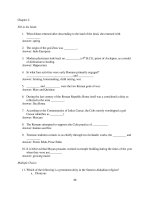A history of the worlds religions 13th edition noss test bank
Bạn đang xem bản rút gọn của tài liệu. Xem và tải ngay bản đầy đủ của tài liệu tại đây (54.04 KB, 9 trang )
Chapter 2:
Fill in the blank
1. When Ishtar returned after descending to the land of the dead, she returned with
_________.
Answer: spring
2. The origin of the god Zeus was _________.
Answer: Indo-European
3. Modern physicians look back on _________, a 4th B.C.E. priest of Asclepius, as a model
of dedication to healing.
Answer: Hippocrates
4. In what four activities were early Romans primarily engaged?
_________,__________,___________, and __________.
Answer: farming, homemaking, child raising, war
5. _________ and __________ were the two Roman gods of war.
Answer: Mars and Quirinus
6. During the last century of the Roman Republic Rome itself was a considered a deity as
reflected in the term _________.
Answer: Dea Roma
7. According to the Commentaries of Julius Caesar, the Celts mostly worshipped a god
Caesar identifies as _________/
Answer: Mercury
8. The Romans attempted to suppress the Celts practice of __________.
Answer: human sacrifice
9. Teutonic tradition comnes to us chiefly through two Icelandic works, the _________ and
_________.
Answer: Poetic Edda, Prose Edda
10. It is believed that Mayan peasants worked on temple building during the times of the year
when they were not________.
Answer: growing maize
Multiple Choice
11. Which of the following is a prominent deity in the Sumero-Akkadian religion?
a. Dionysus
68
b. Hesiod
c. Hunab Ku
d. Ishtar
Answer: D
12. The Sumero-Akkadian pantheon numbered nearly
a. 1000
b. 1200
c. 2000
d. 2200
Answer: C
13. The rise of Babylon brought this Sumero-Akkadian to prominenece.
a. Hammurabi
b. Marduk
c. Ninurta
d. Nabu
Answer: B
14. The Sumerians believed that heaven and earth arose from _________.
a. air
b. the stars in the heavens
c. the primordial sea
d. the vast cosmos
Answer: C
15. The Gilgamesh Epic tells of a _________ visited upon the earth by angry gods.
a. earthquake
b. famine
c. flood
d. plague
Answer: C
16. Which of the following was a duty of Zeus?
a. to bring fish from the sea
b. to bring rain
c. to protect the earth
d. to protect the hearth
Answer: B
17. Hera may have originally been _________.
a. a cow goddess
b. a fertitlity goddess
c. the goddess of the lakes
d. the goddess of wild things
69
Answer: A
18. As a result of his exploits at Delphi, _________ became the god of revelation.
a. Apollo
b. Aesculapius
c. Dionysus
d. Zeus
Answer: A
19. Where did Homer depict the gods living?
a. at Delphi
b. in the deep of the sea
c. in the underworld
d. on high Olympus
Answer: D
20. How did Hesiod attempt to bring the gods ito some semblance of order?
a. by acknowledging moira
b. by combining the minor gods into one
c. through theogony
d. by using mysterium tremendium
Answer: C
21. Why did Persephone have to make an annual visit to the underworld?
a. she had eaten food while captive in the underworld
b. she had married while captive in the underworld
c. to retain her powers
d. to purify herself in the fires
Answer: A
22. To what did the tragic poets attribute all disasters and doom?
a. human frailty
b. immoral behavior by humans
c. the cosmos
d. the gods
Answer: D
23. Plato believed that the Greek gods were dependent in function on _________.
a. a higher power
b. fear of the rath of Zeus
c. the immorality of humankind
d. truth, beauty, and goodnesss
Answer: A
24. Where were the chief holy places of early Rome located?
70
a. in a cluster in the heart of Rome
b. in temples hidden in the countryside
c. outside the territory of Rome
d. throughout Rome
Answer: C
25. Which of the following is NOT a deity to whom early Roman farmers turned when they
desired success in farming?
a. Ceres
b. Consus
c. Minerva
d. Saturnus
Answer: C
26. How many days per year did the Roman state prescribe for ceremonies and sacrifices to
the Roman deities?
a. 44
b. 84
c. 104
d. 124
Answer: C
27. In the Roman conceptual system, Jupiter’s most exalted title was _________.
a. Jupiter Optimus
b. Maximus Pater
c. Optimus Maximus
d. Pater Olympus
Answer: C
28. What was the origin of the Sibylline books consulted by Roman priests?
a. Etruscan
b. Greek
c. Iranian
d. Roman
Answer: B
29. There were three hereditary orders among the Celts of Gaul and of Ireland. What is the
term used to identify the priests?
a. Druides
b. Equites
c. Numena
d. Plebs
Answer: A
30. Which of the following was NOT a primary concern of the Teutonic peoples?
71
a. death
b. fertility
c. sickness
d. the end of the world
Answer: C
31. The ancient Mayans focused sharply on the sacred significance of __________.
a. fruit
b. light
c. time
d. water
Answer: C
32. According to the Mayan conceptual system, the sky dome had how many compartments?
a. 6
b. 7
c. 11
d. 13
Answer: D
33. How many days were in the Mayan’s seasonal maize-crop year?
a. 120
b. 260
c. 365
d. 380
Answer: C
34. Even in modern times the Maya retain a devout attitude toward which of the following?
a. material structures
b. sources of sustenance
c. the association of colors and nature
d. the calendar
Answer: C
35. Each stage of a Mayan’s life was dominated by what?
a. calendric horoscopes interpreted by priests
b. public ceremonial sacrifices
c. the growing cycle of maize
d. the shape of the sky dome
Answer: A
72
CHAPTER 2: Bygone Religions
Chapter Objectives
After reading this chapter, the student should be able to:
List the major deities of Mesopotamia and discuss their impact on later religious cultures.
Analyze the origins of Greek gods and explain the intermingling of various religious cultures
when conquering societies affect local belief systems.
Look beyond the classic literature of the Roman period to understand religious foundations
and calculate the impact of political aims, imperialism, and transitional socioeconomic
conditions on spiritual beliefs.
Recognize the impact of invading Indo-Europeans on many western religious traditions and
describe the unique belief systems the ancient Celts and Teutons carried with them while
assimilating with conquered peoples.
Understand the fundamental attitudes toward devotion and the sacred in ancient Mayan
culture.
Chapter Summary
Many major deities arose from the ancient Mesopotamian region. Ishtar was a near
universally worshipped female deity of the Sumero-Akkadian and her greatest rival was Marduk
of Babylon. The Babylonian myths and epics lend themselves to study through the varied but
rich cuneiform inscriptions left behind. Many of the myths have parallels with later religious
traditions (e.g. Hebrews). The role of sacrifice, magic, divination and astrology in Babylonian
worship are discussed in the context of the precise and accurate instruments they developed.
The influences on the development of Greek deities are addressed and the complex
functions of their major deities are explored. Zeus exemplifies the sublimation of local gods by
the gods of the northern invaders of Greece as do Hera, his wife, and Apollo. The various roles
and origins of Artemis, Hermes, Poseidon, Athena, Demeter, Persephone and Aphrodite are
mentioned. The practice of religion in Greece involved household pieties and attendance at
festivals (e.g. Athenian). The Mystery religions are a venue for private worship and include the
Eleusinian, the Dionysian and Orphic cults. The Greek poets and the defining influence on Greek
deities are addressed as is the influence of the Greek philosophers Plato and Aristotle.
The true nature of Roman religion distinct from the depictions rendered by the literature
of the period is discussed from the early period, and from a private or home life perspective. The
changes due to the influence of Etruscan dominance, starting in the sixth century BCE are
described, chief among them are the imbuing of the gods with anthropomorphic characteristics.
The influence of the Greeks and cults from the Eastern Mediterranean areas on Roman religion
4
are explored. The failure of latter phases of the Roman period and the rise of the Imperial cult to
provide a cohesive social force are explored briefly.
Religion in Europe beyond the Alps is observed in the Celts and Teutons. Both had a
focus on fertility and practiced sacrificial offerings of animals and humans. The religion of the
Maya of Mesoamerica are the last of the religions discussed. There deities appear in four modes:
1) celestial and remote; 2) fertility and domestic; 3) death and war; and 4) calendar and
ceremonial.
Chapter Outline
I.
II.
Mesopotamia
A.
The Sumero-Akkadian Pantheon
1. Ishtar, a Universal Goddess
2. Marduk of Babylon
B.
The Babylonian Myths and Epics
1. The Creation
2. The Flood
3. Ishtar Descends to the Land of the Dead, Returns with Spring
4. The Journey of Gilgamesh
C.
Sacrifice and Magic
D.
Divination and Astrology
Greece
A.
The Gathering of the Gods in Early Hellas
B.
The Mingled Pantheon
C.
Interaction with the Gods
D.
The Complex Functions of the Major Deities
1. Zeus
2. Hera
3. Apollo
4. Other Dieties
E.
Homer: The Gods as a Family
1. Divine Functions Rationalized
2. The Primacy of Moira
F.
Hesiod’s Theogony
G.
The Everyday Religion of the Household
H.
The Athenian Festivals
I.
The Mystery Religions
1. The Eleusinian Mysteries
2. The Dionysiac and Orphic Cults
J.
Greek Religion and the Tragic Poets
5
K.
III.
IV.
V.
The Philosophers and the Gods
1. Plato
2. Aristotle
Rome
A.
The Religion of Early Rome
B.
The Religion of the Home
C.
The Religion of the State
1. Jupiter
2. Mars and Quirinus
3. Janus and Vesta
D.
Changes Due to Etruscan Influence
E.
Borrowings from the Greeks
F.
Cults from Eastern Mediterranean Areas
G.
The Last Phases
H.
The Imperial Cult
Europe Beyond the Alps
A.
The Celts
1. The Druids
2. Nature Divinities and Fertility Rites
3. Sacrificial Practices
B.
The Teutons
1. Fertility, Death, and Doom
2. Snorri’s Prose Epic
Mesoamerica: the Maya
A.
The Shape of the World
B.
The Shape and Feel of Time
C.
Priests, Royalty, and Peasant
D.
The Deities
1. Celestial
2. Fertility
3. Death and War
4. Calendric and Ceremonial
E.
Rites of Passage
F.
Individual Offerings and Prayers
G.
Public Ceremonial Sacrifices
Discussions Questions
6
1. Cosmology is the study (or argument) of first cause. How is this question addressed or
recognized in the primal religions from Babylonian to Greek and Roman? What similarities
can be found? Do the differences reflect increasing sophistication or something else?
2. Most religious cultures describe their gods in anthropomorphic terms, taking analogies and
symbols from human life and personality. Can you think of any modern examples of
anthropomorphism in religious cultures? What characteristics are emphasized? What
characteristics are similar to those in primal religions?
7









